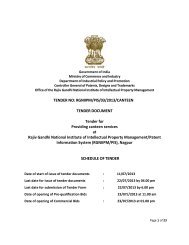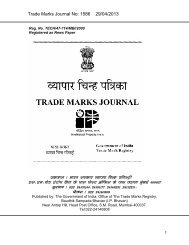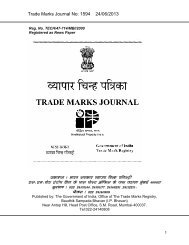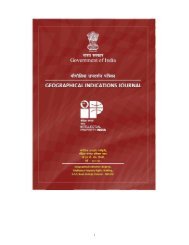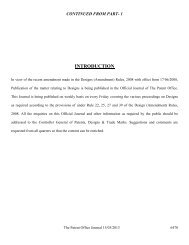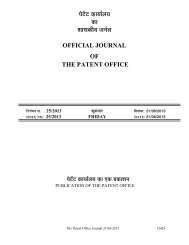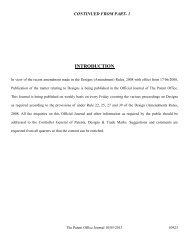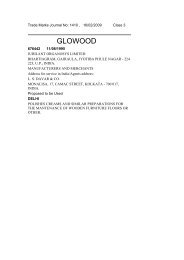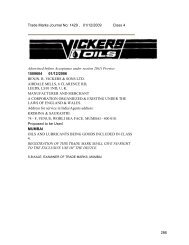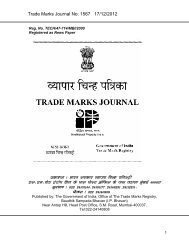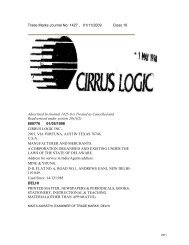Guidelines for Examination of Biotechnology Applications for Patent
Guidelines for Examination of Biotechnology Applications for Patent
Guidelines for Examination of Biotechnology Applications for Patent
Create successful ePaper yourself
Turn your PDF publications into a flip-book with our unique Google optimized e-Paper software.
GUIDELINES FOR EXAMINATION OF BIOTECHNOLOGY APPLICATIONS FOR PATENT<br />
1. INTRODUCTION<br />
<strong>Biotechnology</strong> exploits biological materials, living or non-living, and is broadly classified<br />
as classical and modern biotechnology. The age-old fermentation process <strong>for</strong> producing<br />
alcohol, isolation <strong>of</strong> antibiotics from moulds or other micro-organisms are only a few<br />
examples <strong>of</strong> classical biotechnology. Modern biotechnology started with the gene splicing<br />
technology or genetic engineering which developed in the late seventies <strong>of</strong> the last century.<br />
By using genetic engineering, many useful things like human insulin, human growth factors,<br />
monoclonal antibodies, etc. have been developed.<br />
The biotechnological inventions there<strong>for</strong>e include products and/ or processes <strong>of</strong> gene<br />
engineering technologies, methods <strong>of</strong> producing organisms, methods <strong>of</strong> isolation <strong>of</strong> microorganisms<br />
from culture medium, methods <strong>of</strong> mutation, cultures, mutants, trans<strong>for</strong>mants,<br />
plasmids, processes <strong>for</strong> making monoclonal antibodies, cell lines <strong>for</strong> making monoclonal<br />
antibodies, etc. While on the one side, biotechnological inventions have resolved many<br />
problems and branched out to several fields, on the other side, they have invoked many<br />
debates. The application <strong>of</strong> genetic engineering in plants and animals has resulted in<br />
exciting and yet debatable technological developments such as transgenic plants, animals<br />
and isolation <strong>of</strong> human genes <strong>for</strong> using them to produce medicaments.<br />
Scientists across the world are using bioin<strong>for</strong>matics tools, ingenious techniques and<br />
genomes <strong>of</strong> organisms to probe the mysteries <strong>of</strong> biological processes and the living world<br />
thereby generating vast amounts <strong>of</strong> in<strong>for</strong>mation which may provide the keys to new medical<br />
treatments, improved crops and so on.<br />
However, there are some issues relating to patentability <strong>of</strong> biotechnological inventions<br />
which are <strong>of</strong> serious concern to the users <strong>of</strong> <strong>Patent</strong> System such as novelty, obviousness,<br />
industrial applicability, extent <strong>of</strong> disclosure and clarity in claims. In addition, a few special<br />
issues have also evolved such as those relating to moral and ethical concerns,<br />
environmental safety, issues relating to patenting <strong>of</strong> ESTs (Expressed Sequence Tags) <strong>of</strong><br />
partial gene sequences, cloning <strong>of</strong> farm animals, stem cells, gene diagnostics, etc. Thus, the<br />
patenting <strong>of</strong> inventions in the field <strong>of</strong> biotechnology poses challenges to the applicants <strong>for</strong><br />
patents as well as to the <strong>Patent</strong> Office. There<strong>for</strong>e, there is an urgent need to put in place<br />
<strong>Guidelines</strong> to establish uni<strong>for</strong>m and consistent practices in the examination <strong>of</strong> patent<br />
applications in the field <strong>of</strong> biotechnology and allied subjects under the <strong>Patent</strong>s Act, 1970.<br />
Thus the guidelines are intended to help the examiners and controllers <strong>of</strong> the <strong>Patent</strong> Office<br />
so as to achieve uni<strong>for</strong>mity and consistency.<br />
However, these guidelines do not constitute rule making. In case <strong>of</strong> any conflict between<br />
these guidelines and the provisions <strong>of</strong> the <strong>Patent</strong>s Act, 1970 and the <strong>Patent</strong>s Rules, 2003,<br />
the said provisions <strong>of</strong> Act and Rules will prevail over these guidelines. The guidelines are<br />
subject to revision from time to time based on interpretations by a Court <strong>of</strong> Law, statutory<br />
amendments and valuable inputs from the stakeholders.<br />
1
2. BRIEF HISTORY OF PATENTING OF BIOTECHNOLOGY IN INDIA<br />
Till 2002, as per the prevailing practice in the <strong>Patent</strong> Office, patents were not granted <strong>for</strong><br />
inventions relating to (a) living entities <strong>of</strong> natural or artificial origin, (b) biological materials<br />
or other materials having replicating properties, (c) substances derived from such materials<br />
and (d) any processes <strong>for</strong> the production <strong>of</strong> living substances/entities including nucleic acids.<br />
However, patents could be granted <strong>for</strong> processes <strong>of</strong> producing non-living substances by<br />
chemical processes, bioconversion and microbiological processes using micro-organisms or<br />
biological materials. For instance, claims <strong>for</strong> processes <strong>for</strong> the preparation <strong>of</strong> antibodies or<br />
proteins or vaccines consisting <strong>of</strong> non-living substances were allowable.<br />
In 2002, the Hon’ble Calcutta High Court, in its decision in ‘Dimminaco AG v. Controller<br />
<strong>of</strong> <strong>Patent</strong>s and Designs’, opened the doors <strong>for</strong> the grant <strong>of</strong> patents to inventions where the<br />
final product <strong>of</strong> the claimed process contained living microorganisms. The court concluded<br />
that a new and useful art or process is an invention, and where the end product (even if it<br />
contains living organism) is a new article, the process leading to its manufacture is an<br />
invention. The Dimminaco case was related to a process <strong>for</strong> the preparation <strong>of</strong> a live vaccine<br />
<strong>for</strong> protecting poultry against Bursitis infection. The Controller <strong>of</strong> <strong>Patent</strong>s had refused the<br />
application <strong>for</strong> grant <strong>of</strong> patent on the ground that the vaccine involved processing <strong>of</strong> certain<br />
microbial substances and contained gene sequence. The Controller had decided that the<br />
said claim was not patentable because the claimed process was only a natural process<br />
devoid <strong>of</strong> any manufacturing activity and the end-product contained living material.<br />
The Hon’ble High Court held that the word “manufacture” was not defined in the statute<br />
there<strong>for</strong>e, the dictionary meaning attributed to the word in the particular trade or business<br />
can be accepted if the end product is a commercial entity. The court further held that there<br />
was no statutory bar in the patent statute to accept a manner <strong>of</strong> manufacture as patentable<br />
even if the end product contained a living organism. The court asserted that one <strong>of</strong> the most<br />
common tests was the vendibility test. The said test would be satisfied if the invention<br />
resulted in the production <strong>of</strong> some vendible item or it improved or restored the <strong>for</strong>mer<br />
conditions <strong>of</strong> the vendible item or its effect was the preservation and prevention from<br />
deterioration <strong>of</strong> some vendible product. The court further stated that the vendible product<br />
meant something which could be passed on from one man to another upon transaction <strong>of</strong><br />
purchase and sale. In other words, the product should be a commercial entity.<br />
The subsequent major step, which further opened the arena <strong>of</strong> grant <strong>of</strong> patents in the<br />
field <strong>of</strong> biotechnology, was in the year 2002 when the <strong>Patent</strong>s Act, 1970 was amended by<br />
the <strong>Patent</strong>s (Amendment) Act, 2002 where biochemical, biotechnological and<br />
microbiological processes were included within the scope <strong>of</strong> chemical processes <strong>for</strong> the<br />
grant <strong>of</strong> patent. The definition <strong>of</strong> “invention” was also changed to “any new product or<br />
process involving an inventive step and capable <strong>of</strong> industrial application” thereby deleting<br />
the word “manner <strong>of</strong> manufacture” as mentioned in the earlier Act.<br />
India joined the Budapest Treaty on the International Recognition <strong>of</strong> the Deposit <strong>of</strong><br />
Microorganisms <strong>for</strong> the Purposes <strong>of</strong> <strong>Patent</strong> Procedure on 17 th December 2001.<br />
Consequently, section 10 <strong>of</strong> the Act was amended in 2002 to provide <strong>for</strong> deposition <strong>of</strong> the<br />
2
iological material and its reference in the patent application in case the invention relates to<br />
a biological material which is not possible to be described in a sufficient manner and which<br />
is not available to the public. The <strong>Patent</strong>s Act, 1970 was amended by the <strong>Patent</strong>s<br />
(Amendment) Act, 2005 paving the way <strong>for</strong> the grant <strong>of</strong> product patents in any field <strong>of</strong><br />
technology including biotechnology with certain exceptions keeping in view the national<br />
policy to protect the public interest. The Act, as amended, recognizes the International<br />
Depository Authorities (IDAs) under the Budapest Treaty.<br />
3. BIODIVERSITY RELATED ISSUES<br />
The Biological Diversity Act, 2002 (hereinafter referred to as BD Act) provides a<br />
mechanism <strong>for</strong> access to the genetic resources and benefit sharing accrued therefrom.<br />
Section 6 <strong>of</strong> the BD Act came into <strong>for</strong>ce on 1 st July 2004, and prescribes that obtaining IPRs<br />
from the utilization <strong>of</strong> biological resources in India is subject to the approval <strong>of</strong> the National<br />
Biodiversity Authority (hereinafter referred to as NBA).<br />
To facilitate this access and benefit sharing and in order to prevent any unauthorized use<br />
<strong>of</strong> the biological resources <strong>of</strong> India, in 2005 suitable amendments were made in Section 10<br />
<strong>of</strong> the <strong>Patent</strong>s Act, 1970, wherein disclosure <strong>of</strong> the source and geographical origin <strong>of</strong> the<br />
biological material was made mandatory in an application <strong>for</strong> patent when the said material<br />
is used in an invention. In addition, a declaration by the applicant regarding the required<br />
permission from the competent authority was inserted in Form 1 <strong>of</strong> the <strong>Patent</strong>s Rules, 2003.<br />
There<strong>for</strong>e, the issues related to the BD Act and those related to mandatory disclosure <strong>of</strong><br />
the source and geographical origin constitute an essential element <strong>of</strong> examination <strong>of</strong><br />
biotechnology related subject matters.<br />
In view <strong>of</strong> the above background, the guidelines <strong>for</strong> the examination <strong>of</strong> patent<br />
applications in the field <strong>of</strong> biotechnology and allied subjects within the <strong>Patent</strong> Office have<br />
become essential in order to establish uni<strong>for</strong>m and consistent practice. The guidelines as set<br />
out below are supplemental to the practices and procedures followed by <strong>Patent</strong> Office as<br />
published in the ‘Manual <strong>of</strong> <strong>Patent</strong> Office Practice and Procedure’.<br />
4. PROVISIONS COVERED<br />
The following sections <strong>of</strong> the <strong>Patent</strong>s Act, 1970 are emphasised in the context <strong>of</strong><br />
examination <strong>of</strong> applications in biotechnology and allied fields:<br />
I. Section 2 (1) (j): Novelty, inventive step & industrial applicability <strong>of</strong> products or<br />
processes,<br />
II.<br />
III.<br />
Section 3 (b): Inventions contrary to morality or which cause serious prejudice to<br />
human, animal or plant life or health or environment,<br />
Section 3 (c): Discovery <strong>of</strong> any living thing or non-living substance occurring in<br />
nature,<br />
3
IV.<br />
Section 3 (d): Mere discovery <strong>of</strong> new <strong>for</strong>m <strong>of</strong> known substance which does not result<br />
in enhancement <strong>of</strong> known efficacy or mere discovery <strong>of</strong> any new property or new<br />
use <strong>for</strong> a known substance,<br />
V. Section 3 (e): Mere admixture resulting only in aggregation <strong>of</strong> the properties,<br />
VI.<br />
VII.<br />
VIII.<br />
IX.<br />
Section 3 (h): Method <strong>of</strong> agriculture and horticulture,<br />
Section 3 (i): Method <strong>of</strong> treatment and diagnosis,<br />
Section 3 (j): Plants and animals in whole or any part there<strong>of</strong> other than microorganisms,<br />
but including seeds, varieties and species, and essentially biological<br />
processes,<br />
Section 3 (k): Computer programs per se and algorithms, mathematical methods,<br />
X. Section 3 (p): Inventions which are in effect traditional knowledge,<br />
XI.<br />
XII.<br />
Section 10 (4): Sufficiency <strong>of</strong> disclosure and the best method <strong>of</strong> per<strong>for</strong>ming the<br />
invention, and<br />
Section 10 (5): Unity <strong>of</strong> invention and clarity, succinctness and support <strong>of</strong> the claims.<br />
5. CLAIMS OF BIOTECHNOLOGICAL INVENTIONS<br />
The details <strong>of</strong> wording <strong>of</strong> claims, clarity, support and sufficiency <strong>of</strong> the disclosure are<br />
discussed under appropriate headings. However, <strong>for</strong> better understanding <strong>of</strong> the issues<br />
related to novelty and inventive step, it is felt that we should begin with a preliminary<br />
discussion <strong>of</strong> claims <strong>of</strong> biotechnology related inventions which are usually filed in patent<br />
applications <strong>of</strong> the relevant fields.<br />
Usually the biotechnology applications comprise the claims relating to the following<br />
subject matters:<br />
(a) Polynucleotides or gene sequences (product and/or process),<br />
(b) Polypeptides or protein sequences (product and/or process),<br />
(c) Vectors (e.g., plasmids) (product and/or process),<br />
(d) Gene constructs or cassettes and gene libraries,<br />
(e) Host cells, microorganisms and stem cells (product and/or process), transgenic cells,<br />
(f) Plants and animals tissue culture (product and/or process)<br />
(g) Pharmaceutical or vaccine compositions comprising microorganisms, proteins,<br />
polynucleotides (product and/or process),<br />
(h) Antibodies or antigen binding fragments there<strong>of</strong> (monoclonal or polyclonal),<br />
4
(i) Diagnostic kits and tests, and<br />
(j) Diagnostic tests (products/process) such as a test <strong>for</strong> the detection <strong>of</strong> a mutation in a<br />
gene/protein which might be associated with a particular condition such as protein<br />
expression or a disease.<br />
6. PRIOR ART SEARCH<br />
While conducting a prior art search, the Examiner should design a comprehensive<br />
search strategy by combining various search parameters including key words, IPC,<br />
sequences, etc. and thorough search should be carried out in patent as well as non-patent<br />
databases.<br />
If a patent application discloses sequence listing <strong>of</strong> nucleotides and/or amino acids<br />
as per Rule 9 (1) <strong>of</strong> the <strong>Patent</strong>s Rules 2003, the same shall also be filed in electronic <strong>for</strong>m.<br />
To facilitate the processing <strong>of</strong> patent applications, the sequence listings should be filed in<br />
computer readable <strong>for</strong>mat. The examiner should carry out the sequence search on the<br />
commercial databases available to the <strong>of</strong>fice and freely available databases using diverse<br />
search tools such as BLAST, FASTA, etc.<br />
7. NOVELTY<br />
In the case <strong>of</strong> biotechnological inventions the assessment <strong>of</strong> novelty shall be carried<br />
out in the same manner as <strong>for</strong> other inventions. For the purpose <strong>of</strong> ascertaining novelty<br />
during the examination, the prior art is to be construed as prescribed under Section 13 (read<br />
with Sections 29 to 34) <strong>of</strong> the Act. The Manual <strong>of</strong> <strong>Patent</strong> Office Practice & Procedure has set<br />
out the guidelines <strong>for</strong> assessment <strong>of</strong> novelty <strong>of</strong> inventions (Chapter 8, Para 08.03.02) that<br />
may be referred to.<br />
According to Section 2 (1) (j) <strong>of</strong> the Act, an "invention" means a new product or<br />
process involving an inventive step and capable <strong>of</strong> industrial application. An invention will<br />
be patentable only if it is new in the light <strong>of</strong> prior art, or is not anticipated by prior art. The<br />
prior art includes all in<strong>for</strong>mation and knowledge relating to the invention, which is available<br />
in any publication be<strong>for</strong>e the date <strong>of</strong> priority <strong>of</strong> the patent application. For the purpose <strong>of</strong><br />
examination, an invention will not be new if it <strong>for</strong>ms part <strong>of</strong> the prior art or has entered the<br />
public domain. For anticipation, such publication must be be<strong>for</strong>e the date <strong>of</strong> priority <strong>of</strong> the<br />
patent application. Also, any application <strong>for</strong> patent filed in India, but published after the<br />
date <strong>of</strong> filing <strong>of</strong> a subsequent application <strong>for</strong> patent in India claiming the same subjectmatter<br />
shall be treated as a prior art (i.e. prior claiming) to the said subsequent application<br />
provided that the previous application has earlier priority date.<br />
7.1. PRODUCT-BY-PROCESS CLAIMS<br />
A claim to a product obtained or produced by a process is anticipated by any prior<br />
disclosure <strong>of</strong> that particular product per se, regardless <strong>of</strong> its method <strong>of</strong> production.<br />
Examples <strong>of</strong> ‘Product-by-process’ claims–<br />
(a) A polypeptide/compound which is the product <strong>of</strong> the method according to claim X.<br />
5
(b) A transgenic microorganism obtained by the method ….characterized in that …..”<br />
(c) A plasmid obtained by the method <strong>of</strong> ……<br />
Such claims are admissible only if the products themselves fulfil the requirement <strong>of</strong><br />
patentability over the prior art. The claimed products cannot be considered novel merely<br />
due to the novelty in the processes by which they are produced, but rather novelty can<br />
only be established, if technical evidences are provided showing that the modifications in<br />
the processes result in other products which are distinct with regard to their properties<br />
over the products known in the prior art. Such technical evidences may vary from case to<br />
case.<br />
7.2. SEQUENCE CLAIMS<br />
A claim to a polynucleotide sequence that was available, e.g. as part <strong>of</strong> a library<br />
be<strong>for</strong>e the priority date, lacks novelty, even if activity or function <strong>of</strong> the said sequence <strong>of</strong><br />
the polynucleotide has not been previously determined. A claim to a specific fragment <strong>of</strong><br />
polynucleotide may be considered to be novel, but subject to fulfilment <strong>of</strong> the inventive<br />
step and non-patentability under relevant clauses <strong>of</strong> Section 3 <strong>of</strong> the Act.<br />
A prior disclosure <strong>of</strong> the same sequence as the claimed sequence, even without any<br />
indication <strong>of</strong> its activity, would prima facie constitute anticipation to the novelty <strong>of</strong> the<br />
claimed sequence. The reasoning is that the earlier sequence inherently possesses the<br />
activity <strong>of</strong> the claimed sequence. If any sequence <strong>of</strong> a polynucleotide/polypeptide from a<br />
prior art does not exactly match with the claimed sequence <strong>of</strong><br />
polynucleotide/polypeptide, then the subject-matter <strong>of</strong> such claims cannot be said to be<br />
anticipated by the prior art sequence. However, such sequence <strong>of</strong><br />
polynucleotide/polypeptide <strong>of</strong> the prior art would be relevant <strong>for</strong> deciding inventive step or<br />
non-patentability under relevant clauses <strong>of</strong> Section 3 <strong>of</strong> the Act.<br />
7.3. COMBINATION/COMPOSITION CLAIMS<br />
Quite <strong>of</strong>ten, the claims <strong>of</strong> combination <strong>of</strong> products <strong>of</strong> biotechnology escape the<br />
question <strong>of</strong> novelty and are dealt under the inventive step or relevant clauses <strong>of</strong> Section 3 <strong>of</strong><br />
the Act. However, sometimes it may happen that the combination has already fallen in the<br />
public domain and hence, to be dealt under novelty.<br />
ILLUSTRATIVE EXAMPLE:<br />
Claim: A composition useful against diphtheria toxin, comprising anti-diphtheria antibodies<br />
together with acceptable preservatives and stabilizers, wherein the antibodies are obtained<br />
from chicken egg yolk (IgY).<br />
Prior art discloses a composition useful against the diphtheria toxin comprising antibodies<br />
obtained from chicken egg yolk, physiologically acceptable carrier and other additives &<br />
adjuvants. The prior art further discloses a process <strong>for</strong> preparing egg yolk antibodies by<br />
employing the same steps right from an immunization <strong>of</strong> a chicken with a diphtheria antigen<br />
to antibodies purification as claimed in the present invention.<br />
6
Analysis: The claim lacks novelty, as being anticipated by the said prior art which discloses<br />
all the features <strong>of</strong> claimed composition useful against the diphtheria toxin. Thus, the<br />
claimed subject matter lacks novelty.<br />
8. INVENTIVE STEP<br />
The Manual <strong>of</strong> <strong>Patent</strong> Office Practice & Procedure has set out the guidelines <strong>for</strong><br />
assessment <strong>of</strong> Inventive Step <strong>of</strong> inventions (Chapter 8, Para 08.03.03) that may be referred<br />
to. An invention should possess an inventive step in order to be eligible <strong>for</strong> patent<br />
protection. As per the <strong>Patent</strong>s Act, an invention will have inventive step if the invention<br />
involves (a) technically advanced as compared to existing knowledge or (b) having economic<br />
significance or (c) both, and that makes the invention not-obvious to a person skilled in the<br />
art.<br />
ILLUSTRATIVE EXAMPLE:<br />
Claim: An isolated DNA sequence encoding a mature human IL-3 protein having a proline<br />
residue at position 8 <strong>of</strong> the mature polypeptide, said protein possessing bone marrow<br />
proliferation-inducing activity in a human bone marrow proliferation assay.<br />
Difference with prior art is that the claimed compound at position 8, there was a proline<br />
moiety whereas in the prior art compound in the same position there was a serine<br />
molecule.<br />
Analysis: Primate IL-3 are part <strong>of</strong> family proteins which are similar in their amino acid<br />
sequences, but are minor variants or point mutations <strong>of</strong> each other. A single variation in the<br />
amino acid sequence does not normally change the activity and function <strong>of</strong> the protein<br />
unless the single variation is in a critical region <strong>of</strong> the protein. The applicant could not<br />
provide any evidence that the protein coded by the claimed DNA was any different from<br />
that <strong>of</strong> the prior art in its chemical properties. Thus, the inventive step cannot be<br />
acknowledged.<br />
The claimed subject-matter would lack inventive step if it is obvious to a person<br />
skilled in the relevant art in view <strong>of</strong> a single prior art or a mosaic <strong>of</strong> the relevant prior art<br />
documents.<br />
ILLUSTRATIVE EXAMPLE 1:<br />
Claim: An improved process <strong>for</strong> the production <strong>of</strong> galactooligosaccharides (GOS) <strong>of</strong> high<br />
yield and purity comprising the steps <strong>of</strong>: (i) isolating Bullera singularis and Saccharomyces<br />
sp. (ii) immobilizing the B. Singularis and Saccharomyces sp; (iii) hydrolysis <strong>of</strong> lactose by the<br />
immobilized microbial cells, said reaction being carried out until galactose content being at<br />
least 65 % and (iv) optionally concentrating the galactooligosaccharides solution.<br />
Prior Art: D1 discloses a process <strong>for</strong> the production <strong>of</strong> galacto-oligosaccharides from lactose<br />
using immobilized B. singularis cells. D1 does not explicitly teach the combined use <strong>of</strong> B.<br />
Singularis and Saccharomyces sp. in the production <strong>of</strong> galacto-oligosaccharides.<br />
7
D2 discloses the use <strong>of</strong> Saccharomyces sp. <strong>for</strong> the production <strong>of</strong> galacto-oligosaccharides<br />
from lactose. It further discloses that Saccharomyces sp. uses lactose as a carbon source &<br />
approximately it removes 92% <strong>of</strong> glucose from the GOS mixture by fermentation without<br />
losing the GOS content.<br />
Analysis: Since it is evident from D2 that Saccharomyces sp. consume glucose, one <strong>of</strong><br />
ordinary person skilled in the art would be motivated to use Saccharomyces sp. in<br />
combination with B. singularis to solve the problem <strong>of</strong> separation <strong>of</strong> saccharides and also,<br />
reducing the competitive inhibition <strong>of</strong> beta-galactosidase enzyme by glucose, which leading<br />
to high yield & purity <strong>of</strong> GOS. Thus, the claimed subject-matter lacks inventive step.<br />
ILLUSTRATIVE EXAMPLE 2:<br />
Claim: A culture independent method <strong>of</strong> removal <strong>of</strong> plasmids from live and multiplying<br />
plasmid containing bacteria comprising the following steps: (a) preparing an aqueous first<br />
suspension <strong>of</strong> sub-micronic silver particles; (b) estimating MIC (minimum inhibitory<br />
concentration) <strong>of</strong> the silver particles <strong>for</strong> the bacteria to determine the inhibitory<br />
concentration <strong>of</strong> the particles suspension <strong>for</strong> the bacteria; (c) adding in a reaction vessel,<br />
the first suspension and growth medium <strong>of</strong> the bacteria to obtain a second suspension<br />
containing sub-MIC concentration <strong>of</strong> silver particles; (d) introducing the bacteria in the<br />
reaction vessel under conditions favouring the multiplication <strong>of</strong> the bacteria, <strong>for</strong> 12 to 48<br />
hrs., to obtain subsequent generations <strong>of</strong> the bacteria and (e) testing the bacterial<br />
generations <strong>for</strong> absence <strong>of</strong> plasmids to obtain a generation <strong>of</strong> plasmid free bacteria.<br />
Prior art discloses a method in which an antimicrobial activity <strong>of</strong> silver nano-particles against<br />
E. coli was investigated as a model <strong>for</strong> Gram-negative bacteria. Bacteriological tests were<br />
per<strong>for</strong>med in LB medium on solid agar plates and in liquid systems supplemented with<br />
different concentrations <strong>of</strong> silver nano-sized particles. To examine the effect <strong>of</strong> silver<br />
nanoparticles on Gram-negative bacteria, approximately 105 colony-<strong>for</strong>ming units (CFU) <strong>of</strong><br />
E. coli strain were cultured on LB agar plates supplemented with silver nano-sized particles<br />
in the concentrations <strong>of</strong> 10 to 100 µg cm -3 . Silver-free LB plates cultured under the same<br />
conditions were used as a control. The plates were incubated <strong>for</strong> 24 hours at 37 O C. E. coli<br />
bacteria were grown in 100 cm3 <strong>of</strong> liquid LB medium supplemented with 10, 50, & 100 µg <strong>of</strong><br />
these particles per cm3 <strong>of</strong> medium. Growth rates & bacterial concentrations were<br />
determined by measuring optical density (OD) at 600 nm each 30 min (OD <strong>of</strong> 0.1<br />
corresponds to a concentration <strong>of</strong> 108 cells per cm3). The size and morphology <strong>of</strong> the silver<br />
nanoparticles were examined by transmission electron microscopy (TEM). The results<br />
confirmed that the treated E. coli cells were damaged, showing <strong>for</strong>mation <strong>of</strong> “pits” in the<br />
cell wall <strong>of</strong> the bacteria, while the silver nanoparticles were found to accumulate in the<br />
bacterial membrane. A membrane with such morphology exhibits a significant increase in<br />
permeability, which leads to leaking <strong>of</strong> intracellular substances (that is admitted by the<br />
applicant on page 16, 3rd paragraph in the specification <strong>of</strong> the present invention). The TEM<br />
micrograph also shows coagulation <strong>of</strong> nano-sized particles at the bacterial surface.<br />
Analysis: Prior art discloses each and every aspect <strong>of</strong> claimed invention right from the<br />
selection <strong>of</strong> E. coli strain, preparation <strong>of</strong> silver nanoparticles, culturing <strong>of</strong> the bacterial strain<br />
with different concentration <strong>of</strong> silver nanoparticles, conditions <strong>for</strong> bacterial growth and<br />
assessment <strong>of</strong> effect <strong>of</strong> silver nanoparticles on gram negative bacteria. Prior art does not<br />
8
explicitly teach removal <strong>of</strong> plasmid from bacteria; however, it teaches that the silver<br />
nanoparticles were responsible <strong>for</strong> significantly increasing the permeability <strong>of</strong> bacterial cell<br />
membrane that leads to leaking <strong>of</strong> intracellular substances (which may include plasmids)<br />
from E. coli. Thus, the teaching <strong>of</strong> cited art would motivate a person having ordinary skill in<br />
the art with reasonable expectation <strong>of</strong> success to provide an alternative method <strong>for</strong> removal<br />
<strong>of</strong> plasmids from plasmid containing bacteria in order to solve the problem faced with<br />
plasmid containing bacteria using varied concentration <strong>of</strong> silver nanoparticles, as these<br />
particles effectively increase bacterial cell membrane permeability leading to removal <strong>of</strong><br />
intracellular substances, which may include plasmids. Thus, the claimed subject-matter lacks<br />
inventive step in view <strong>of</strong> prior art.<br />
If the claimed invention relates to a polynucleotide/polypeptide having<br />
mutation(s) in a known sequence <strong>of</strong> polynucleotide/polypeptide, which does not result in<br />
an unexpected property whatsoever, then the claimed subject-matter lacks inventive<br />
step.<br />
ILLUSTRATIVE EXAMPLE 1:<br />
Claim: Pro-insulin having a C-peptide encompassing only two amino acids selected from Arg-<br />
Lys, Lys-Lys and Lys-Arg*.<br />
(*Human Pro-insulin is comprised <strong>of</strong> three chains, A, B and C, in the insulin the two chains<br />
are combined eliminating the third chain, i.e. the C–chain consisting <strong>of</strong> thirty amino acids).<br />
Prior art discloses natural Pro-insulin having 30 amino acids C-peptide, Pro-insulin with C-<br />
peptide as short as two amino acids (Arg-Arg).<br />
Analysis: The claim was held to be prima facie obvious. The applicant argued that the yield<br />
<strong>of</strong> claimed Pro-insulin having a C-peptide expressed in yeast is 1.6 to 2.0 mmol/l whereas<br />
the yield <strong>of</strong> the prior art Pro-insulin with a C-chain <strong>of</strong> Arg-Arg is only 1.0 mmol/l. Such a<br />
difference in change did not constitute ‘unexpected property’ and hence, the subject-matter<br />
is held to be obvious.<br />
ILLUSTRATIVE EXAMPLE 2:<br />
Claim: A recombinant DNA sequence <strong>of</strong> SEQ ID NO: X encoding human interferon α2<br />
polypeptide.<br />
Prior art discloses a nucleic acid sequence <strong>of</strong> SEQ ID NO: X1 encoding human interferon α1<br />
polypeptide.<br />
Analysis: The claimed human interferon α2 is structurally close to the prior art’s human<br />
interferon α1. However, the alleged invention can be held non-obvious, because <strong>of</strong> the fact<br />
that the claimed human interferon is thirty times more potent in its antiviral activity than its<br />
prior art analogue.<br />
9
9. INDUSTRIAL APPLICATION<br />
As per Section 2(1) (ac) <strong>of</strong> the Act, the expression “capable <strong>of</strong> industrial application”,<br />
in relation to an invention, means that the invention is capable <strong>of</strong> being made or used in an<br />
industry”. Further, Section 64 (1) (g) <strong>of</strong> the Act provides that a patent is liable to be revoked<br />
if the invention is not useful.<br />
To be patentable an invention must be useful and capable <strong>of</strong> industrial application.<br />
The specification should disclose the usefulness and industrial applicability <strong>of</strong> an invention in<br />
a distinct and credible manner unless the usefulness and industrial applicability <strong>of</strong> the<br />
invention is already established, either in explicit or in implicit manner.<br />
In the context <strong>of</strong> the gene sequences, it may be said that whatever ingenuity is<br />
involved in discovering a gene sequence, one cannot have a patent <strong>for</strong> it or a protein<br />
encoded by it unless it is disclosed how it can be used. It is there<strong>for</strong>e necessary to consider<br />
whether the invention claimed has a useful purpose, and whether the specification<br />
identifies any practical way <strong>of</strong> using it.<br />
ILLUSTRATIVE EXAMPLE 1:<br />
Claim: A polypeptide in substantially isolated <strong>for</strong>m comprising a contiguous sequence <strong>of</strong> at<br />
least 10 amino acids encoded by the genome <strong>of</strong> hepatitis C virus (HCV) and comprising an<br />
antigenic determinant, wherein HCV is characterized by: (i) a positive stranded RNA<br />
genome; (ii) said genome comprising an open reading frame (ORF) encoding a polyprotein;<br />
and (iii) said polyprotein comprising an amino acid sequence having at least 40% homology<br />
to the 859 amino acid sequence X.<br />
Upon examination it was found that the above claim was sufficiently enabled and its<br />
use was properly established in the specification. There<strong>for</strong>e, claim 1 was allowable.<br />
Another claim <strong>of</strong> the specification read as “A polypeptide in substantially isolated<br />
<strong>for</strong>m whose sequence is shown in any one <strong>of</strong> SEQ IDs 1, 3 to 32, 36, 46 and 47, or whose<br />
sequence is encoded in a polynucleotide selectively hybridisable with the polynucleotide as<br />
shown in any one <strong>of</strong> SEQ IDs 1, 3-32, 36,46 or 47."<br />
Upon examination, it was seen that the said claim covered an almost vast number <strong>of</strong><br />
polypeptides <strong>for</strong> which no use was established and the said claim there<strong>for</strong>e, was not<br />
allowable on the ground that it lacked industrial applicability.<br />
The use <strong>of</strong> claimed subject-matter (e.g. a gene or a protein) disclosed in the<br />
specification should not be merely speculative, rather the said use should be specific,<br />
substantial and credible <strong>for</strong> establishing industrial applicability <strong>of</strong> the claimed subjectmatter.<br />
ILLUSTRATIVE EXAMPLE 2:<br />
Claim 1: A V28 protein (V28) having a function as a receptor (<strong>of</strong> a kind known as 7TM).<br />
Claim 2: A method <strong>of</strong> verifying the function <strong>of</strong> a V28 protein as claimed in claim 1.<br />
10
Analysis: The function <strong>of</strong> V28 protein as a receptor was based on prediction upon various<br />
structural elements in the deduced amino acid sequence and homology to known 7TM<br />
receptors but the specification disclosed no ligand. The use <strong>of</strong> the invention is disclosed in<br />
the specification, which is however based on a proposed function <strong>of</strong> the V28 protein as a<br />
receptor that is not sufficiently disclosed in the specification. Thus, the use disclosed in the<br />
application is speculative, i.e. is not specific, substantial and credible and as such is not<br />
considered industrially applicable.<br />
9.1. FRAGMENTS/ESTs<br />
Fragments/ESTs (Expression Sequence Tag) are allowable if they in addition to other<br />
conditions satisfy the question <strong>of</strong> usefulness and industrial application. An EST whose use is<br />
disclosed simply as a ‘gene probe’ or ‘chromosome marker’ would not be considered to<br />
have an industrial application. A credible, specific and substantial use <strong>of</strong> the EST should be<br />
disclosed, <strong>for</strong> example use as a probe to diagnose a specific disease.<br />
10. SECTION 3 (B): INVENTIONS CONTRARY TO MORALITY OR WHICH CAUSE<br />
SERIOUS PREJUDICE TO HUMAN, ANIMAL OR PLANT LIFE OR HEALTH OR ENVIRONMENT<br />
<strong>Biotechnology</strong> deals with living subject matters and involves alteration <strong>of</strong> genomic<br />
materials <strong>of</strong> an organism. Such change may influence or may have a deep impact upon the<br />
environment or the human, animal or plant life or may involve serious questions about<br />
morality. Hence, adequate care should be taken while examining the inventions vis-a-vis<br />
their primary or intended use or commercial exploitation and it should be carefully dealt<br />
so that the subject-matter must not be contrary to public order, morality or causes serious<br />
prejudice to human, animal or plant life or health or to the environment. A few non<br />
limiting examples may further clarify the issues: (a) a process <strong>for</strong> cloning human beings or<br />
animals; (b) a process <strong>for</strong> modifying the germ line <strong>of</strong> human beings; (c) a process <strong>for</strong><br />
modifying the genetic identity <strong>of</strong> animals which are likely to cause them suffering without<br />
any substantial medical or other benefit to man or animal, and also animals resulting from<br />
such process; (d) a process <strong>for</strong> preparing seeds or other genetic materials comprising<br />
elements which might cause adverse environmental impact; (e) uses <strong>of</strong> human embryos <strong>for</strong><br />
commercial exploitation.<br />
11. SECTION 3(C): SCIENTIFIC PRINCIPLES OR ABSTRACT THEORY OR DISCOVERY OF<br />
LIVING THINGS OR NON-LIVING SUBSTANCES<br />
According to Section 3 (c) <strong>of</strong> the Act, the mere discovery <strong>of</strong> a scientific principle or<br />
the <strong>for</strong>mulation <strong>of</strong> an abstract theory or discovery <strong>of</strong> any living thing or non-living substance<br />
occurring in nature is not a patentable invention. Products such as microorganisms, nucleic<br />
acid sequences, proteins, enzymes, compounds, etc., which are directly isolated from<br />
nature, are not patentable subject-matter. However, processes <strong>of</strong> isolation <strong>of</strong> these<br />
products can be considered subject to requirements <strong>of</strong> Section 2 (1) (j) <strong>of</strong> the Act.<br />
ILLUSTRATIVE EXAMPLE 1:<br />
Claim: Bacillus sp. IN123 comprising rDNA (ribosomal DNA) sequence represented as SEQ ID<br />
NO: 1 (deposition No. XXXXXX).<br />
11
Analysis: The subject-matter <strong>of</strong> claim falls within the scope <strong>of</strong> Section 3 (c) <strong>of</strong> the Act, as it<br />
attempts to claim an isolated Bacillus sp. IN123 (i.e. a living substance) occurring in nature<br />
(i.e. from soil as disclosed in the specification). Thus, what is claimed in the claim is treated<br />
as a discovery <strong>of</strong> a living thing occurring in nature and hence, not patentable.<br />
ILLUSTRATIVE EXAMPLE 2:<br />
Claim: A novel agent <strong>for</strong> promoting cardiac development activity, said agent having SEQ ID<br />
NO: 1, wherein the agent is obtained from the perivitelline fluid <strong>of</strong> horseshoe crab,<br />
Tachypleus gigas.<br />
Analysis: The subject-matter is not patentable under Section 3 (c) <strong>of</strong> the Act, because the<br />
claim attempts to claim an agent, which is isolated from perivitelline fluid <strong>of</strong> embryos <strong>of</strong><br />
horseshoe crab, Tachypleus gigas (i.e. a peptide which is non-living substance occurring in<br />
nature). As per Section 3 (c) <strong>of</strong> the Act, a non-living substance occurring in nature is not<br />
patentable subject-matter and thus, it is not patentable.<br />
ILLUSTRATIVE EXAMPLE 3:<br />
Claim: An isolated peptide that is structural equivalent <strong>of</strong> a cupredoxin or cytochrome that<br />
can inhibit parasitemia in malaria-infected red blood cells and intracellular replication <strong>of</strong> a<br />
malarial parasite in malaria-infected human red blood cells.<br />
Analysis: The subject-matter <strong>of</strong> claim falls within the scope <strong>of</strong> Section 3 (c) <strong>of</strong> the Act,<br />
because the disclosure does not clearly indicate what modifications/alterations/deletions<br />
are made in the wild-type peptides. In fact, the definition <strong>of</strong> a word “isolated” used in claims<br />
refers to materials, which are substantially or essentially free from components, which<br />
normally accompany the materials as they found in their natives states. Thus, the subjectmatter<br />
<strong>of</strong> claim is considered to be isolated non-living substances occurring in the nature<br />
and functional features <strong>for</strong> said isolated peptide is considered inherent to a cupredoxin or a<br />
cytochrome proteins, which is not patentable as per Section 3 (c) <strong>of</strong> the Act.<br />
12. SECTION 3(D): DISCOVERY OF NEW FORM OF KNOWN SUBSTANCE WHICH<br />
DOES NOT RESULT IN ENHANCEMENT OF EFFICACY<br />
Section 3 (d) <strong>of</strong> the Act requires that any minor modifications in the already existing<br />
substance in the prior art are not patentable unless the improved property/efficacy <strong>of</strong> the<br />
modified substance is established.<br />
ILLUSTRATIVE EXAMPLE:<br />
Claim: Pre-protein A being one <strong>of</strong> the factors which primarily control glucose metabolism in<br />
mammals having C-peptide, wherein said C-peptide comprises two amino acids selected<br />
from XY, YZ and ZX.<br />
Analysis: Prior art discloses modified protein A having C-peptide, wherein said C-peptide<br />
consists <strong>of</strong> amino acids XX. The applicant failed to demonstrate any therapeutic efficacy as a<br />
result <strong>of</strong> claimed modification over the prior art. Hence, the subject-matter <strong>of</strong> claim is not<br />
patentable under Section 3 (d) <strong>of</strong> the Act.<br />
12
The inventions relating to three-dimensional or crystal structure <strong>of</strong> a polypeptide<br />
attracts the provision <strong>of</strong> Section 3 (d) <strong>of</strong> the Act unless it is proved that such polypeptide<br />
differs significantly in the properties with regards to therapeutic efficacy.<br />
ILLUSTRATIVE EXAMPLE:<br />
Claim: A crystal <strong>of</strong> a peptide consisting <strong>of</strong> SEQ ID NO: A, wherein said crystal comprises an<br />
asymmetric unit, said asymmetric unit comprises four molecules <strong>of</strong> said peptide per Zn 2+<br />
and further wherein the crystal belongs to space group X, Y, Z.<br />
Analysis: The amorphous <strong>for</strong>ms <strong>of</strong> peptide <strong>of</strong> SEQ ID NO: A are known. The applicant failed<br />
to demonstrate any significant improvement in properties with regards to the therapeutic<br />
efficacy over the known amorphous peptide. Hence, it is not allowable under Section 3 (d)<br />
<strong>of</strong> the Act.<br />
13. SECTION 3 (E): MERE ADMIXTURE RESULTING ONLY IN AGGREGATION OF THE<br />
PROPERTIES OR A METHOD OF MAKING SUCH MERE ADMIXTURE<br />
It is a well accepted principle <strong>of</strong> <strong>Patent</strong> Law that mere placing side by side <strong>of</strong> old<br />
integers so that each per<strong>for</strong>ms its own proper function independently <strong>of</strong> any <strong>of</strong> the others<br />
is not a patentable combination, but that where the old integers when placed together<br />
has some working interrelation producing a new or improved result, then there is<br />
patentable subject matter in the idea <strong>of</strong> the working inter relations brought about by the<br />
collocation <strong>of</strong> the integers.<br />
In Ram Pratap v Bhaba Atomic Research Centre (1976) IPLR 28 at 35, it was held that<br />
a mere juxtaposition <strong>of</strong> features already known be<strong>for</strong>e the priority date which have been<br />
arbitrarily chosen from among a number <strong>of</strong> different combinations which could be chosen<br />
was not a patentable invention.<br />
Section 3(e) <strong>of</strong> the Act reflects the legislative intent on the law <strong>of</strong> patenting <strong>of</strong><br />
combination inventions in the field <strong>of</strong> chemical as well as biotechnological sciences.<br />
ILLUSTRATIVE EXAMPLE:<br />
Claim: A composition <strong>of</strong> innovative combination <strong>of</strong> dormant spore <strong>of</strong> naturally occurring<br />
Paecilomyces lilacinus and Arthrobotrys sp. fungus with enzymes, fats and growth<br />
promoting molecules to control plant-parasitic nematodes.<br />
Analysis: The subject-matter <strong>of</strong> claim falls within the scope <strong>of</strong> Section 3 (e) <strong>of</strong> the Act. Upon<br />
examination, it is found that the claim is directed to a composition <strong>of</strong> two known fungal<br />
species. The said two species used in the alleged invention are known <strong>for</strong> their nematode<br />
bio-control activity. The specification is silent on advantages <strong>of</strong> a combinative effect <strong>of</strong> these<br />
two fungal species over the sum <strong>of</strong> their individual effects. Thus, the subject-matter <strong>of</strong> the<br />
claim is not patentable under Section 3 (e) <strong>of</strong> the Act.<br />
13
14. SECTION 3 (H): METHOD OF AGRICULTURE AND HORTICULTURE<br />
According to Section 3 (h) <strong>of</strong> the Act, a method <strong>of</strong> agriculture or horticulture is not<br />
considered as patentable subject matter. While deciding patentability under Section 3 (h),<br />
conventional methods per<strong>for</strong>med on actual open fields should be construed as method <strong>of</strong><br />
agriculture/horticulture.<br />
ILLUSTRATIVE EXAMPLE:<br />
Claim: A method <strong>of</strong> growing leguminous plants as inter-cropping <strong>for</strong> improving fertility <strong>of</strong><br />
soil by augmenting nitrogen content <strong>of</strong> the soil.<br />
Analysis: The subject-matter <strong>of</strong> the claim is agriculture method and hence, falls within the<br />
scope <strong>of</strong> Section 3 (h) <strong>of</strong> the Act.<br />
15. SECTION 3 (I): METHOD OF TREATMENT<br />
According to Section 3 (i) <strong>of</strong> the Act, any process <strong>for</strong> the medicinal, surgical, curative,<br />
prophylactic, diagnostic, therapeutic or other treatment <strong>of</strong> human beings or any process <strong>for</strong><br />
a similar treatment <strong>of</strong> animals to render them free <strong>of</strong> disease or to increase their economic<br />
value or that <strong>of</strong> their products is not an invention. In the context <strong>of</strong> Section 3 (i), the Manual<br />
<strong>of</strong> <strong>Patent</strong> Office Practice & Procedure states that this provision excludes from the<br />
patentability the followings:<br />
(a) Medicinal methods: As <strong>for</strong> example a process <strong>of</strong> administering medicines orally,<br />
or through injectables, or topically or through a dermal patch.<br />
(b) Surgical methods: As <strong>for</strong> example a stitch-free incision <strong>for</strong> cataract removal.<br />
(c) Curative methods: As <strong>for</strong> example a method <strong>of</strong> cleaning plaque from teeth.<br />
(d) Prophylactic methods: As <strong>for</strong> example a method <strong>of</strong> vaccination.<br />
(e) Diagnostic methods: Diagnosis is the identification <strong>of</strong> the nature <strong>of</strong> a medical<br />
illness, usually by investigating its history and symptoms and by applying tests.<br />
Determination <strong>of</strong> the general physical state <strong>of</strong> an individual (e.g. a fitness test) is<br />
considered to be diagnostic.<br />
(f) Therapeutic methods: The term “therapy’’ includes prevention as well as<br />
treatment or cure <strong>of</strong> disease. There<strong>for</strong>e, the process relating to therapy may be<br />
considered as a method <strong>of</strong> treatment and as such not patentable.<br />
(g) Any method <strong>of</strong> treatment <strong>of</strong> animal to render them free <strong>of</strong> disease or to increase<br />
their economic value or that <strong>of</strong> their products. As <strong>for</strong> example, a method <strong>of</strong> treating<br />
sheep <strong>for</strong> increasing wool yield or a method <strong>of</strong> artificially inducing the body mass <strong>of</strong><br />
poultry.<br />
14
(h) Further examples <strong>of</strong> subject matters excluded under this provision are: any<br />
operation on the body, which requires the skill and knowledge <strong>of</strong> a surgeon and<br />
includes treatments such as cosmetic treatment, the termination <strong>of</strong> pregnancy,<br />
castration, sterilization, artificial insemination, embryo transplants, treatments <strong>for</strong><br />
experimental and research purposes and the removal <strong>of</strong> organs, skin or bone<br />
marrow from a living donor, any therapy or diagnosis practiced on the human or<br />
animal body and further includes methods <strong>of</strong> abortion, induction <strong>of</strong> labour, control<br />
<strong>of</strong> estrus or menstrual regulation.<br />
(i) Application <strong>of</strong> substances to the body <strong>for</strong> purely cosmetic purposes is not therapy.<br />
(j) <strong>Patent</strong> may however be obtained <strong>for</strong> surgical, therapeutic or diagnostic<br />
instrument or apparatus. Also the manufacture <strong>of</strong> prostheses or artificial limbs and<br />
taking measurements there<strong>of</strong> on the human body are patentable.<br />
Sometimes the claims are so drafted that a combination/composition <strong>of</strong> drugs in<br />
certain dosage <strong>for</strong>ms is claimed, but the claimed subject-matter relates to application or<br />
administration <strong>of</strong> individual drugs in simultaneous, sequential or concomitant manner. In<br />
such cases, although the claims are directed to a combination/composition <strong>of</strong> drugs, but the<br />
claimed invention resides in the method <strong>of</strong> administration <strong>of</strong> individual drugs in the said<br />
manner and thus, it falls within the scope <strong>of</strong> section 3 (i) <strong>of</strong> the Act.<br />
ILLUSTRATIVE EXAMPLE:<br />
Claim: A method <strong>of</strong> monitoring drug response in a patient suffering from cancer treated<br />
with a combination <strong>of</strong> Gemcitabine and P1446A, comprising detection <strong>of</strong> a gene signature<br />
with at least two drug response markers, wherein the said drug response markers are<br />
selected from the group consisting <strong>of</strong> P21, REV3L, FGF5, PTK7, POLH, P27 and SSTR2.<br />
Analysis: The subject-matter <strong>of</strong> claim is directed to method <strong>of</strong> diagnosis <strong>of</strong> human beings or<br />
animals, which are statutorily barred from the patentability under Section 3 (i) <strong>of</strong> the Act.<br />
Hence, the subject-matter <strong>of</strong> claim is not patentable.<br />
16. SECTION 3 (J): PLANTS & ANIMALS IN WHOLE OR ANY PART, SEEDS, VARIETIES,<br />
SPECIES OTHER THAN MICROORGANISMS & ESSENTIALLY BIOLOGICAL PROCESSES ARE<br />
NOT PATENTABLE SUBJECT MATTER<br />
According to Section 3 (j) <strong>of</strong> the Act, plants and animals in whole or any part there<strong>of</strong><br />
other than micro-organisms but including seeds, varieties and species and essentially<br />
biological processes <strong>for</strong> production or propagation <strong>of</strong> plants and animals are not patentable<br />
inventions.<br />
Although, microorganisms are excluded from non-patentability list, a conjoined<br />
reading with Section 3 (c) <strong>of</strong> the Act implies that only modified microorganisms, which do<br />
not constitute discovery <strong>of</strong> living thing occurring in nature, are patentable subject matter<br />
under the Act.<br />
15
Claims relating to essential biological processes <strong>of</strong> growing plants, germination <strong>of</strong><br />
seeds, <strong>of</strong> development stages <strong>of</strong> plants and animals shall be objected under Section 3 (j) <strong>of</strong><br />
the Act.<br />
ILLUSTRATIVE EXAMPLE 1:<br />
Claims: A therapeutic composition <strong>for</strong> treating an immune-related disorder in a mammalian<br />
subject, the composition comprises as an effective ingredient ex vivo educated autologous<br />
NK T cells capable <strong>of</strong> modulating Th1/Th2 cell balance toward anti-inflammatory cytokine<br />
producing cells and optionally comprising pharmaceutically acceptable carrier, diluent,<br />
excipient and/or additive.<br />
Analysis: The claimed subject-matter falls within the scope <strong>of</strong> Section 3 (j) <strong>of</strong> the Act <strong>for</strong><br />
claiming ex vivo educated autologous NK T cells in the <strong>for</strong>m <strong>of</strong> therapeutic composition.<br />
Although the claim is directed to a composition, but there is nothing like a composition; in<br />
fact the educated autologous NK T cells alone would be treated as a final product, because<br />
other ingredients are kept as optional. Just by wording a claim as a composition claim<br />
comprising additional one or more routine ingredients (<strong>for</strong> example pharmaceutically<br />
acceptable carriers) has no effect on the final product and it does not exclude the claim<br />
from falling within the scope <strong>of</strong> Section 3 (j) <strong>of</strong> the Act.<br />
ILLUSTRATIVE EXAMPLE 2:<br />
Claim: A method <strong>of</strong> producing at least one <strong>of</strong> substantially pure hybrid seeds, plants and<br />
crops, comprising the steps <strong>of</strong> (i) producing a male parent which is male fertile, (ii) breeding<br />
the male parent with a female parent which is substantially male sterile, and (iii) harvesting<br />
seeds from the female parent which contain pure hybrid seeds.<br />
Analysis: The claimed method involves the step <strong>of</strong> cross breeding <strong>for</strong> producing pure hybrid<br />
seeds, plants and crops. Thus, it is an essentially biological process and not allowable under<br />
Section 3 (j) <strong>of</strong> the Act.<br />
17. SECTION 3 (K): MATHEMATICAL OR BUSINESS METHOD OR A COMPUTER<br />
PROGRAMME PER SE OR ALGORITHMS<br />
According to Section 3 (k) <strong>of</strong> the Act, a mathematical or business method or a<br />
computer programme per se or algorithms are not patentable inventions. Bio-in<strong>for</strong>matics is<br />
a relatively young science and has emerged from the combination <strong>of</strong> in<strong>for</strong>mation<br />
technology and biotechnology. Thus, the determination <strong>of</strong> patentability <strong>of</strong> inventions<br />
relating to bioin<strong>for</strong>matics requires special attention vis-a-vis exclusions under Section 3 (k)<br />
<strong>of</strong> the Act.<br />
ILLUSTRATIVE EXAMPLE 1:<br />
Claim: A data processing method, wherein a first chemical substance is a compound; a<br />
second chemical substance is nucleic acid, protein or a complex there<strong>of</strong>; a first characteristic<br />
amount is expressed as a vector comprised <strong>of</strong> more than one type <strong>of</strong> chemical substance<br />
in<strong>for</strong>mation <strong>of</strong> the first chemical substance; a second characteristic amount is expressed as<br />
a vector comprised <strong>of</strong> more than one type <strong>of</strong> biological in<strong>for</strong>mation <strong>of</strong> the second chemical<br />
16
substance; and the first characteristic amount and the second characteristic amount are<br />
map-trans<strong>for</strong>med using a multivariate analysis technique or a mechanical leaning method so<br />
as to increase a correlation between first space expressing the first characteristic amount<br />
and second space expressing the second characteristic amount.<br />
Analysis: The claimed invention is considered as a mathematical method or computer<br />
programme per se in so far as that it relates to data processing <strong>of</strong> certain technical<br />
parameters <strong>of</strong> chemical and biological substances, but does not lead to any product<br />
whatsoever. Various references to chemical and biological substances therein are only<br />
to the meaning <strong>of</strong> data itself and do not relate to any technical implementation<br />
details <strong>for</strong> carrying out the methods. Hence, the subject-matter <strong>of</strong> claim falls within the<br />
scope <strong>of</strong> statutorily non-patentable inventions under Section 3 (k) <strong>of</strong> the Act.<br />
ILLUSTRATIVE EXAMPLE 2:<br />
Claim: A computer-assisted method <strong>of</strong> generating a compound that inhibits the glutamine<br />
<strong>for</strong>mation active site activity <strong>of</strong> a glutamine synthetase polypeptide, wherein said test<br />
compound is capable <strong>of</strong> inhibiting the interaction between an adenylated catalytic triad site<br />
<strong>of</strong> the glutamine <strong>for</strong>mation active site and a -glutamyl phosphate intermediate, or <strong>of</strong><br />
inhibiting the interaction between an de-adenylated catalytic triad site <strong>of</strong> the glutamine<br />
<strong>for</strong>mation active site and a -glutamyl phosphate intermediate, the method comprising the<br />
steps <strong>of</strong>: (a) providing a three-dimensional structure <strong>of</strong> a glutamine <strong>for</strong>mation active site <strong>of</strong><br />
a glutamine synthetase polypeptide; and (b) designing, based on the three-dimensional<br />
structure, a test compound capable <strong>of</strong> inhibiting the interaction between the glutamine<br />
<strong>for</strong>mation active site and a -glutamyl phosphate intermediate.<br />
Analysis: The claimed method is considered as a mathematical method or computer<br />
programme per se as it relates to a method <strong>of</strong> designing the inhibitory compound based on<br />
three dimensional structures, but does not lead to a real product whatsoever. Thus, the<br />
subject-matter <strong>of</strong> claim falls within the scope <strong>of</strong> statutorily non-patentable inventions under<br />
Section 3 (k) <strong>of</strong> the Act.<br />
18. SECTION 3(P): TRADITIONAL KNOWLEDGE RELATED INVENTIONS<br />
According to Section 3 (p) <strong>of</strong> the Act, an invention which, in effect, is traditional<br />
knowledge or which is an aggregation or duplication <strong>of</strong> known properties <strong>of</strong> traditionally<br />
known component or components is not a patentable subject matter.<br />
For the examination <strong>of</strong> TK related subject matters, separate guidelines have<br />
already been issued by the Office <strong>of</strong> CGPDTM.<br />
ILLUSTRATIVE EXAMPLE:<br />
Claim: Serum <strong>of</strong> pigeon possessing the anti-paralysis activity.<br />
Analysis: The use <strong>of</strong> pigeon serum <strong>for</strong> the treatment <strong>of</strong> paralysis (as it possess anti-paralytic<br />
activity) is a traditional knowledge in India or is an aggregation or duplication <strong>of</strong> known<br />
properties <strong>of</strong> traditionally known component. It is clearly evident from D1 (Mahawar et al.,<br />
“Animals and their products utilized as medicines by the inhabitants surrounding the<br />
17
Ranthambhore National Park, India”, Journal <strong>of</strong> Ethnobiology and Ethnomedicine, 2006,<br />
2:46, see entire document especially Table I), which discloses the use <strong>of</strong> pigeon blood <strong>for</strong><br />
treating paralysis.<br />
19. SUFFICIENCY OF DISCLOSURE, CLARITY & SUPPORT OF THE CLAIMS & UNITY OF<br />
INVENTIONS<br />
Section 10 (4) <strong>of</strong> the Act requires that every complete specification shall fully and<br />
particularly describe the invention and its operation or its use and the method by which it is<br />
to be per<strong>for</strong>med. Every specification shall also disclose the best method <strong>of</strong> per<strong>for</strong>ming the<br />
invention known to the applicant <strong>for</strong> which he is entitled to claim protection. A complete<br />
specification shall end with a set <strong>of</strong> claim(s) defining the scope <strong>of</strong> invention <strong>for</strong> which<br />
protection is sought.<br />
As per Section 10 (5) <strong>of</strong> the Act, the claim(s) shall be clear and succinct and shall be<br />
fairly based on the matter disclosed in the specification.<br />
The purpose <strong>of</strong> the disclosure and the claims are not same and yet mutually<br />
supportive. Whereas, the disclosure <strong>of</strong> the specification constitutes the essential<br />
component <strong>of</strong> the quid pro quo <strong>of</strong> the patent system, the claims notify the public the<br />
<strong>for</strong>bidden area.<br />
While assessing the sufficiency <strong>of</strong> disclosure, the examiner must be careful to<br />
ensure that at least one method <strong>for</strong> per<strong>for</strong>ming the invention must be described so that<br />
the whole subject-matter that is claimed in the claims, and not only a part <strong>of</strong> it, must be<br />
capable <strong>of</strong> being carried out by a skilled person in the relevant art without the burden <strong>of</strong><br />
an undue amount <strong>of</strong> experimentation or the application <strong>of</strong> inventive ingenuity. If the<br />
skilled person, following the directions given in the specification has to find out something<br />
that is new in order to reproduce the invention, the disclosure is insufficient.<br />
Where the claims in an application are broad and indeterminate and <strong>of</strong> a speculative<br />
character, the claims will be treated as not supported by the description.<br />
If the specification discloses a listing <strong>of</strong> a wide range <strong>of</strong> unrelated diseases as<br />
potential future therapeutic or diagnostic targets <strong>of</strong> a claimed gene or the protein that it<br />
encodes, the claims <strong>of</strong> such gene are known as Claims having laundry list. It is possible that<br />
the gene may play an important role in the treatment <strong>of</strong> one or more <strong>of</strong> the listed diseases;<br />
it is unlikely that gene or its product will have a role in all <strong>of</strong> the diseases. Such claims are<br />
generally made when the activity <strong>of</strong> the protein has not been fully characterised, and<br />
there<strong>for</strong>e any potential uses <strong>of</strong> the protein are speculative. Even if the function <strong>of</strong> the<br />
polypeptide has been characterised, and its association with one type <strong>of</strong> disease has been<br />
ascertained, this is not enough to support the use <strong>of</strong> the polypeptide in the diagnosis or<br />
treatment <strong>of</strong> numerous other unrelated diseases. There<strong>for</strong>e, if there is no evidence in the<br />
specification as filed that the gene or polypeptide is <strong>of</strong> therapeutic or diagnostic use in each<br />
different disease listed, then the specification is insufficient.<br />
When claims seek to protect things that are not identified by the applicant at the<br />
time <strong>of</strong> filing the application, but that may be identified in the future by carrying out the<br />
applicant’s process, such claims are not patentable on the ground <strong>of</strong> insufficiency <strong>of</strong><br />
18
description. Thus, the claims reach through to things, which are not yet identified by the<br />
applicant.<br />
In Raj Praksh v Mangatram Chowdhury AIR 1978 Del 1 at 9, it was observed<br />
following Farbewerke Hoechst Aktiengesellschaft Vormals Meister Lucius & Bruning a<br />
Corporation etc. Vs. Unichem Laboratories and Ors”., AIR1969Bom255: the complete<br />
specification must describe “an embodiment” <strong>of</strong> the invention claimed in each <strong>of</strong> the<br />
claims and the description must be sufficient to enable those in the industry concerned to<br />
carry it into effect without their making further inventions “and the description must be<br />
fair, i.e. it must not be unnecessarily difficult to follow”.<br />
An insufficient complete specification cannot become sufficient because <strong>of</strong> general<br />
developments in the state <strong>of</strong> the art after the filing date. The relevant date <strong>for</strong> complying<br />
with the requirement <strong>for</strong> sufficiency is the date <strong>of</strong> complete specification. In other words, a<br />
complete specification should provide enough in<strong>for</strong>mation to allow a person skilled in the<br />
art to carry out substantially all that which falls within the ambit <strong>of</strong> what is claimed.<br />
Analogues or variants <strong>of</strong> polynucleotides or polypeptide sequences, in the <strong>for</strong>m <strong>of</strong><br />
additions, substitutions or deletions, could extend to an almost infinite number <strong>of</strong> variants.<br />
In such cases, the claim should be restricted to variants sharing a common specific activity<br />
with each other that are disclosed in the specification. The said activity disclosed should not<br />
be predictable in nature.<br />
When DNA sequences are claimed on the basis that they hybridise with a specifically<br />
identified probe and that they possess a certain activity, the claim will not be supported if<br />
the hybridisation conditions are not specifically disclosed and if the skilled person needs to<br />
per<strong>for</strong>m an undue experimentation to achieve the desired result.<br />
Claims to antibodies that may have therapeutic or diagnostic potential are<br />
unsupported if a role <strong>for</strong> the target protein in a specific disease has not been identified<br />
and proved by sufficient data.<br />
ILLUSTRATIVE EXAMPLE:<br />
Claim: A method comprising: (i) contacting polypeptide X with a compound to be screened<br />
and determining whether the compound affects the activity <strong>of</strong> the polypeptide and (ii)<br />
<strong>for</strong>mulating any active compound into a pharmaceutical composition.<br />
Analysis: Any method that merely screens existing materials does not give rise to products<br />
and claims resulting from such methods ‘reach through’ to as yet unidentified materials. In<br />
the absence <strong>of</strong> any knowledge <strong>of</strong> any relationship, either from the specification or from<br />
common general knowledge, the skilled person would not know how to produce and use<br />
the compounds. It would require an undue burden <strong>of</strong> experimentation to screen undefined<br />
compounds <strong>for</strong> the desired activity. There will also be a lack <strong>of</strong> support where the function<br />
<strong>of</strong> the compounds identified is not specified.<br />
19
19.1. UNITY OF INVENTION<br />
According to Section 10 (5) <strong>of</strong> the Act, the claim or claims <strong>of</strong> a complete specification<br />
shall relate to a single invention, or to a group <strong>of</strong> inventions linked so as to <strong>for</strong>m a single<br />
inventive concept. In the field <strong>of</strong> gene technology it is quite common <strong>for</strong> a patent<br />
application to claim, a large number <strong>of</strong> polynucleotide and polypeptide sequences. This<br />
raises problems at the various phases <strong>of</strong> the application such as publication stage,<br />
examination especially the searching stage. In particular, it is not always clear whether<br />
claimed sequences relate to a single invention, or to a group <strong>of</strong> inventions linked so as to<br />
<strong>for</strong>m a single inventive concept.<br />
Lack <strong>of</strong> unity may be evident in an application in the following ways:<br />
`A priori’, i.e., be<strong>for</strong>e consideration <strong>of</strong> prior art, if the claims falling in different<br />
groups do not share a same or corresponding technical feature.<br />
`A posteriori’, i.e., after a search <strong>of</strong> the prior art, if the shared technical feature fails<br />
to make a contribution over the prior art.<br />
Examples <strong>of</strong> a priori determination <strong>of</strong> prior art is given as herein below:<br />
ILLUSTRATIVE EXAMPLE OF A PRIORI DETERMINATION OF UNITY OF INVENTION:<br />
1) A DNA construct <strong>for</strong> improved expression <strong>of</strong> a heterologous or homologous<br />
polypeptide comprising: (a) isolated DNA sequence (SEQ ID NO: A) or a portion<br />
there<strong>of</strong> which retains promoter activity adapted <strong>for</strong> recombinant protein expression,<br />
(b) DNA sequence encoding the desired polypeptide such that said DNA sequence is<br />
in operative association with said promoter and is expressed under the control <strong>of</strong> the<br />
said promoter, wherein said isolated DNA sequence is a constitutive promoter <strong>for</strong><br />
citrate synthase (citA) gene from filamentous fungi Aspergillus niger.<br />
2) A DNA construct <strong>for</strong> improved expression <strong>of</strong> a heterologous or homologous<br />
polypeptide comprising: (a) a promoter sequence according to SEQ ID NO: B or a<br />
portion there<strong>of</strong> which retains promoter activity, (b) DNA sequence encoding the<br />
desired polypeptide such that said DNA sequence is in operative association with<br />
said promoter and is expressed under the control <strong>of</strong> the said promoter.<br />
3) A DNA construct <strong>for</strong> improved expression <strong>of</strong> a heterologous or homologous<br />
polypeptide comprising: (a) a promoter sequence according to SEQ ID NO: C or a<br />
portion there<strong>of</strong> which retains promoter activity, (b) DNA sequence encoding the<br />
desired polypeptide such that said DNA sequence is in operative association with<br />
said promoter and is expressed under the control <strong>of</strong> the said promoter.<br />
Analysis: The subject-matter <strong>of</strong> claims 1-3 does not relate to a single invention, or to<br />
a group <strong>of</strong> inventions linked so as to <strong>for</strong>m a single inventive concept as per Section<br />
10 (5) <strong>of</strong> the Act. Thus, claims 1-3 contain following groups <strong>of</strong> inventions:<br />
Group-I: Claim 1 directed to a DNA construct <strong>for</strong> improved expression <strong>of</strong> a<br />
heterologous or homologous polypeptide comprising isolated DNA sequence (SEQ ID<br />
NO: A),<br />
20
Group-II: Claim 2 directed to a DNA construct <strong>for</strong> improved expression <strong>of</strong> a<br />
heterologous or homologous polypeptide comprising isolated DNA sequence (SEQ ID<br />
B) and<br />
Group-III: Claim 3 directed to a DNA construct <strong>for</strong> improved expression <strong>of</strong> a<br />
heterologous or homologous polypeptide comprising isolated DNA sequence (SEQ ID<br />
NO: C).<br />
Upon examination, it is found that the DNA sequences as described SEQ ID NO: A, B<br />
& C do not share any common structural feature. There<strong>for</strong>e, as there is no special technical<br />
feature, which could serve as basis <strong>for</strong> unifying the above-said groups <strong>of</strong> inventions, each <strong>of</strong><br />
these groups has to be considered as a separate invention. Thus, these three groups are said<br />
to lack unity a priori.<br />
ILLUSTRATIVE EXAMPLE OF A POSTERIORI DETERMINATION OF UNITY OF INVENTION:<br />
1) A composition comprising a combination <strong>of</strong> X and Protein Y to identify a gene <strong>for</strong><br />
prostate cancer, wherein X is selected from a group <strong>of</strong> hetero-cycles as depicted in<br />
<strong>for</strong>mula 1 [Formula 1 given]<br />
2) A composition comprising a combination <strong>of</strong> X and Protein Z to identify a gene <strong>for</strong><br />
prostate cancer, wherein X is selected from a group <strong>of</strong> hetero-cycles as claimed in<br />
claim 1.<br />
Analysis: Claims 1-2 contain the following inventions or group <strong>of</strong> inventions, which<br />
are not so linked as to <strong>for</strong>m a single general inventive concept as required u/s 10 (5)<br />
<strong>of</strong> the <strong>Patent</strong>s Act, 1970 (as amended):<br />
Group I: Claim 1 drawn to a composition comprising a combination <strong>of</strong> X and Protein Y<br />
to identify a gene <strong>for</strong> prostrate caner, wherein X is selected from a group <strong>of</strong> heterocycles<br />
as depicted in <strong>for</strong>mula 1.<br />
Group II: Claim 2 drawn to a composition comprising a combination <strong>of</strong> X and Protein<br />
Z to identify a gene <strong>for</strong> prostrate caner, wherein X is selected from a group <strong>of</strong> heterocycles<br />
as claimed in claim 1.<br />
The above said groups are linked by the technical feature “X”. Upon prior art search,<br />
it is found that “X” is already known in the prior art. Thus, this feature is not a special<br />
technical feature, because it does not constitute advancement over the prior art. The unity<br />
<strong>of</strong> invention is treated to be fulfilled only when there is a technical relationship among<br />
inventions involving one or more <strong>of</strong> the same or corresponding special technical features.<br />
Thus, claims 1 & 2 failed to meet the requirements <strong>of</strong> Section 10 (5) <strong>of</strong> the Act.<br />
Consequently, the application may be objected <strong>for</strong> lacking unity a posteriori.<br />
20. DEPOSIT OF BIOLOGICAL MATERIAL<br />
If the invention relates to a biological material which is not possible to be described<br />
in a sufficient manner and which is not available to the public, the application shall be<br />
completed by depositing the material to an International Depository Authority (IDA) under<br />
the Budapest Treaty. The deposit <strong>of</strong> the material shall be made not later than the date <strong>of</strong><br />
21
filing <strong>of</strong> the application in India and a reference <strong>of</strong> the deposit shall be given in the<br />
specification within three months from the date <strong>of</strong> filing <strong>of</strong> the patent application in India.<br />
All the available characteristics <strong>of</strong> the material required <strong>for</strong> it to be correctly identified or<br />
indicated are to be included in the specification including the name, address <strong>of</strong> the<br />
depository institute and the date and number <strong>of</strong> the deposit.<br />
Depositary Authorities: Reference to IDA under the Budapest Treaty under Section<br />
10 (4) should be read with Section 2 (1) (aba) <strong>of</strong> the Act.<br />
21. BIODIVERSITY RELATED ISSUES<br />
It has been discussed in the beginning that biodiversity related matters play a vital<br />
role in the patentability <strong>of</strong> the biological substances. The Biological Diversity Act, 2002<br />
provides mechanism <strong>for</strong> conservation <strong>of</strong> biological diversity, sustainable use <strong>of</strong> its<br />
components and fair and equitable sharing <strong>of</strong> the benefits arising out <strong>of</strong> the use <strong>of</strong> biological<br />
resources, knowledge and <strong>for</strong> matters connected therewith or incidental thereto.<br />
In order to prevent misappropriation <strong>of</strong> biological resources and traditional<br />
knowledge <strong>of</strong> India, the Biological Diversity Act requires that access to the biological<br />
resources <strong>of</strong> India is subject to the equitable benefit sharing through the approval <strong>of</strong><br />
National Biodiversity Authority (NBA). No Intellectual Property Rights (IPRs), including<br />
patents based on research or in<strong>for</strong>mation on biological resources obtained from India shall<br />
be granted without the approval <strong>of</strong> the NBA.<br />
The <strong>Patent</strong>s Act provides interfaces with the process <strong>of</strong> obtaining patents and access<br />
to and benefits sharing from utilization <strong>of</strong> Indian biological resources. Thus, disclosure <strong>of</strong> the<br />
source and geographical origin <strong>of</strong> a biological material used in an application <strong>for</strong> a patent<br />
has been made mandatory as per Section 10 (4) <strong>of</strong> the Act. Also, Section 3 (p) <strong>of</strong> the Act<br />
prohibits patenting <strong>of</strong> any invention which, in effect, is traditional knowledge.<br />
With respect to the patenting <strong>of</strong> inventions related to traditional knowledge and<br />
biological material obtained from India, the instructions issued by the Controller General Of<br />
<strong>Patent</strong>s, Designs and Trademarks should be strictly followed.<br />
[End <strong>of</strong> document]<br />
22




